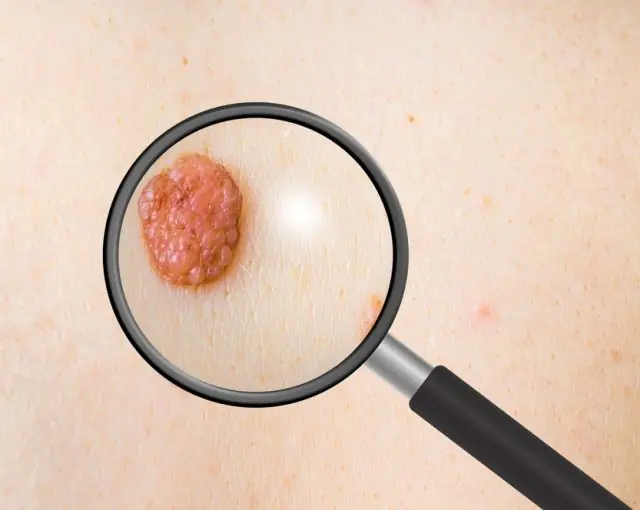
- What is papilloma
- What does melanoma look like?
- How to distinguish
- Can papilloma transform?
The difference between papilloma and melanoma is a set of signs that can be used to determine whether a skin tumor is benign or malignant. Papillomas are viral in nature, melanomas are cancerous tumors on the epidermis. In appearance they may be similar and difficult to distinguish.
What is papilloma?
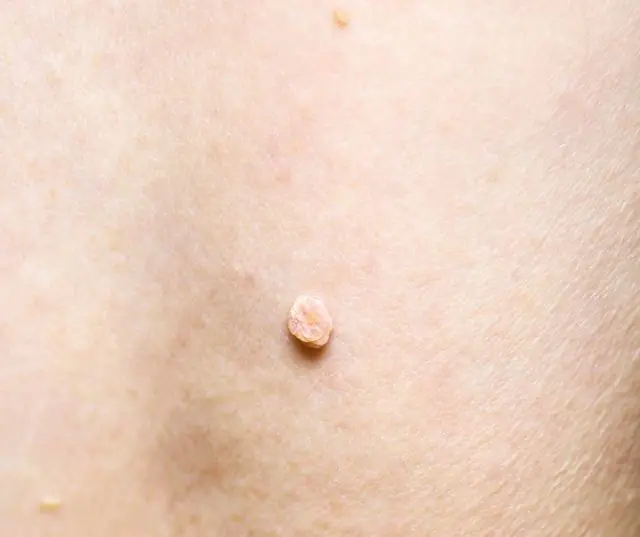
Photo of papilloma
Papilloma is a neoplasm on the skin or mucous membrane that can be localized in different parts of the body. This is an external manifestation of the papillomavirus and its activity in the human body. Today, about 80% of people in the world are infected with HPV.
This infection is transmitted through sexual contact, as well as in everyday life. Sometimes the virus enters the baby's blood during childbirth from an infected mother. HPV is activated when immunity decreases, general weakening of the body, nervous shock, and chronic diseases.
In appearance, papillomas, unlike melanomas, resemble papillary-shaped outgrowths of a flesh-colored, pinkish or brown hue. In most cases, these growths are grouped in the neck, armpits, and face. Sometimes flat or vulgar papillomas form on the extremities.
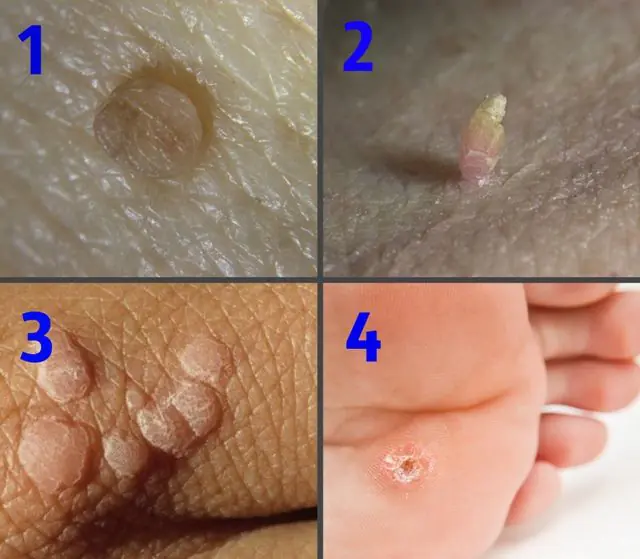
The photo shows types of papillomas
There are many types of papillomas:
- Simple (vulgar). Growths with a rough, hard surface. They usually form on the fingers, hands, and knees. They can form groups. Sometimes they merge into plaques with a diameter of up to 15 mm.
- Filiform. Loose formations that resemble thin outgrowths of epithelium in appearance. They affect the neck, armpits, chest, and face. They are light flesh-colored, painless and soft.
- Flat. They have a more or less regular round shape. Usually accumulate on the limbs and face. It most often affects young people and can resolve on its own.
- Plantar (warts). Their surface is smooth, convex, and may have a protruding rim and small black dots in the center. Such neoplasms of the foot affect and can cause discomfort when walking.
Initially, all papillomas, unlike melanomas, are benign. However, there are a number of HPV strains that are considered conditionally oncogenic. They can lead to papillomas degenerating and becoming cancerous tumors.
What does melanoma look like?
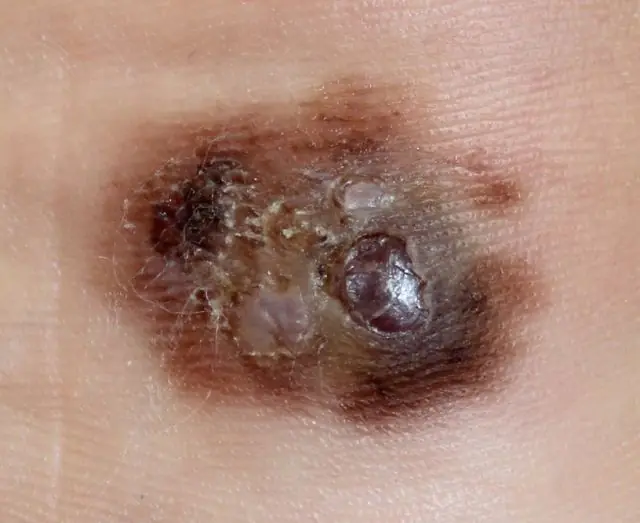
Photo of melanoma
Melanoma is one of the most dangerous cancers. It is characterized by an asymptomatic course and rapid formation of metastases. If this disease is not recognized early, the disease can be fatal.
Papillomas and melanomas are neoplasms that can be similar to each other. However, melanoma is characterized by pronounced negative symptoms:
- Uneven edges of the tumor, blurring of boundaries, unclearness;
- Change in the shade of the growth, darkening, appearance of inclusions;
- Formation of ulcers, cracks, wounds on the surface of the neoplasm;
- Itching, burning, soreness, bleeding.
Melanoma can form either on a clean area of skin, without accumulation of melanin, or on an initially pigmented area of the body. About 30% of skin cancer cases occur due to the degeneration of moles and papillomas.
Melanoma develops through 4 stages. If the disease is detected at the first or second stage, then the prognosis for treatment is favorable, and the chances of a full recovery are very high. If the disease is discovered at the third or fourth stage, when the tumor has metastasized, then the chances of cure are sharply reduced.
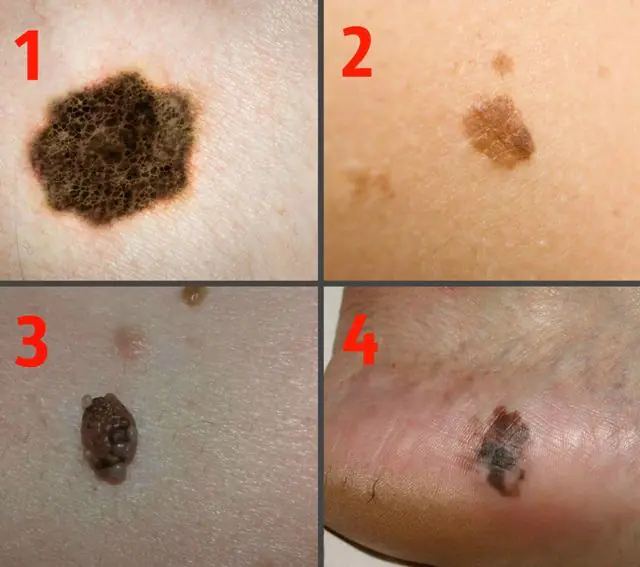
In the photo there are types of melanomas
To understand the difference between papilloma and melanoma, you should also know the types of malignant neoplasms on the skin. Let's look at them:
- Superficial melanoma. It has a heterogeneous shade, irregular shape, and unclear outlines. This is the most common type of skin cancer.
- Lentigo melanoma. It looks like a large pigment spot and appears under the influence of the sun's rays. The rebirth process can take several years. Most often it forms on the face.
- Nodular melanoma. It looks like a nodule that grows upward. May have pink, purple, black color. Quite rare.
- Acral lentiginous melanoma. Focuses on mucous membranes, hands, feet. In appearance it resembles flat growths at the first stage. Then it transforms into nodules.
It is impossible to diagnose skin cancer on your own. Only in clinics after a series of laboratory tests can an accurate diagnosis be established.
- Read also: how to distinguish a mole from a papilloma
How to distinguish melanoma from papilloma?
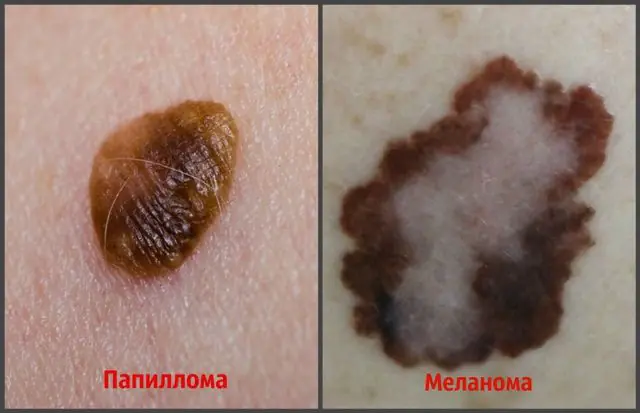
It should be understood that papillomas and melanomas can be quite similar, and you may not be able to distinguish one from the other “by eye”. Especially when it comes to melanoma at the initial stage of development.
However, if there are a number of symptoms that can help distinguish melanoma from papilloma:
- Form. The papilloma has a more or less regular shape, it rises above the surface of the skin. Melanoma may not protrude above the skin, and its shape is irregular and unclear.
- Structure. Papillomas have a soft, loose structure. Melanomas are denser, harder growths.
- Borders. Depending on the variety, papillomas may have different boundaries, but they are not blurred. Melanomas have fuzzy, “floated” edges.
- Color. Ordinary papillomas are a uniform flesh-colored, pink or slightly brownish tint. Melanomas are characterized by a dark color, various inclusions of colors, and heterogeneous colors.
- Discomfort. Normally, papillomas do not hurt, do not itch or cause any discomfort. Melanomas often hurt and itch.
- Discharge of fluids. Papillomas, if they are not injured, never bleed for no reason, and no other physiological fluid is released from them. Melanomas can bleed, and various exudates are often released from them.
It is also worth noting that papillomas are viral tumors. In this case, the pathogen can be transmitted from an infected person to a healthy person through various contacts. Melanoma, unlike papilloma, is the result of an oncological process. It is impossible to get skin cancer from another person.
- Read also about the differences between nevi and papillomas
Can papilloma transform into melanoma?
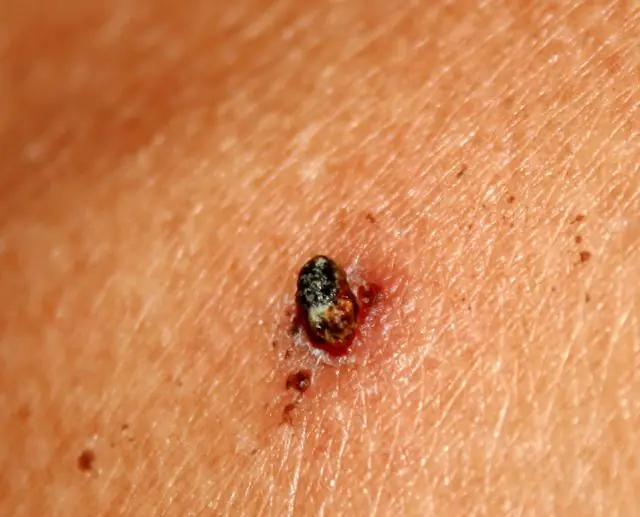
The photo shows the process of degeneration of papilloma into melanoma
It is believed that ordinary moles degenerate into melanoma much more often. However, under unfavorable circumstances, papillomas can also become malignant. People infected with highly oncogenic strains of HPV are especially at risk.
A papilloma that has been injured or is subjected to regular mechanical stress—friction, compression—can also become a malignant tumor.
Let us note the factors that contribute to the degeneration of papilloma into melanoma:
- Naturally light skin tone and red or blond hair;
- A large number of moles, freckles, nevi, papillomas on the body;
- Active emergence of new skin pigmented neoplasms;
- Frequent exposure to direct sunlight, ultraviolet burns;
- Advanced age;
- Presence of a family history of cancer.
It is important to pay attention to any changes in the appearance of papillomas, and even better to treat them in a timely manner by removing them. This way you can minimize the risk of injury and malignancy of papillomas.
- See also what is the difference between papilloma and wart
What is melanoma - watch the video:
At home, without special equipment and research, it is quite difficult to determine the difference between papilloma and melanoma. Therefore, if suspicious tumors appear on the body, you should immediately consult a doctor. This applies even to those growths that do not cause discomfort - at the initial stage, melanoma is painless, but is dangerous due to its consequences.
- Related article: Can papilloma develop into cancer?



